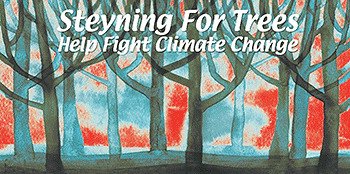
April 2021 - Steyning for Trees
Steyning For Trees is happy to let you know that our first talk, hosted by The Steyning Society, on 20th May 2022 will be given by Sir Charlie Burrell of Knepp Castle Estate; it will be on the benefits of Wildlife Corridors. If you would like to have a preview of this he is giving a Zoom talk for the CPRE, the environmental countryside charity, at 7pm on 31st March 2021. But it will be wonderful to hear him speaking in person next year in the Steyning Centre, a date for your diary.His re-wilding project which began in 2001 has seen numerous Red Data species colonising Knepp and populations of common species rocketing. It is now a hotspot for breeding nightingales, turtle doves and purple emperor butterflies, all so endangered. This success is now influencing thinking across the conservation world.
We have big plans for 2021
SFT is hoping for another busy year, 950 trees already. We are keen to get on with planting trees quickly, in the right places, so they will be reaching maturity by 2030 to help with Greening Steyning’s vision, and our aim, to reduce carbon and pollution and increase biodiversity in this lovely village.
We are also pleased to be working with the Greening Steyning’s Biodiversity Action Group with their plans for planting wildflowers on the verges with our trees. We can use natural solutions to rebalance the damage of climate change. The countryside, as well as exposing the impact of climate breakdown, also provides solutions. Alongside investing in green technology, we need to use the tools nature has to offer, starting with restoring and planting our humble hedgerows in the right places. They not only have the natural ability to lock away carbon but also take harmful emissions out of the air. A hedgerow is a living network where a host of creatures share their home. Remember a tree starts with a single seed. We are carrying on the good work previously done by groups in Steyning.
On average Hedgerows in the UK already store the equivalent of Carbon Emissions from as many as 3.28 Million cars over 10 years. But still the Climate Change Committee has said we need to extend our hedgerows by 40%, equal to around half the length of our national road network to increase this figure. Let’s do our bit to help.
The UK Government has admitted that it is Not On Track to meet its manifesto pledge to plant 300sq. km of trees every year by 2025.
The long-awaited Tree Strategy for England has still not been produced - englandtreestrategy/consultation
Get to know the SFT Committee.
This month we are pleased to have the first contribution from our 10 strong multi-talented/multi-qualified committee. To start us off David Buckett, who so many of you know and by whom many of you were taught, takes up the theme of hedgerows. It is always such a pleasure when we are planting under his guidance to have so many of you coming up and reminiscing about your school days.
Although at Steyning for Trees we have helped sponsor planting of individual specimen trees in our community, we have also been hands-on in the planting of new hedgerows. The value of hedges is that they can provide a complex habitat that achieves many objectives, for example:
• they can act as a windbreak and physical shelter for small mammals, birds and invertebrates.
• by linking different woodland habitats they can provide a wildlife corridor so that prey animals can move safely from one area to another.
• the woody hedgerow plants are often very good for attracting pollinators, such as bees, moths and butterflies.
• many hedgerow plants produce fruit (eg, nuts, berries) that will feed a variety of animals.
• hedgerows are excellent ways of dramatically increasing biodiversity as they attract many different species of plants and animals.
When we plant a hedgerow, we use native species sourced from organisations such as Woodland Trust and we follow their advice on planting them. We have found that the best technique is to put the young “whips” (bare-rooted and 50cm tall) at approximately 50cm spacing in two or three rows.
Using a small spade, we make a ’T’ cut in the turf which we then lever up so that the whip can be dropped in place and the soil gently trodden down. Finally, we wrap a plastic spiral rabbit-protector around the whip and push a bamboo stick down inside the spiral to add support. It is worth noting that we deliberately avoid using extra compost or fertiliser in order to encourage the new roots to spread out. With regard to upkeep, we need to ensure weeds such as fast-growing grasses do not invade the hedge early on, so careful strimming may be used. After about three years, the rabbit protectors and bamboos can be removed and re-used. The hedge can then be lightly trimmed to the desired height and density.
Business Plan for 2021/22.
Steyning for Trees is in the process of producing its Business Plan for 2021/22 using the expertise of its committee members, with their business school and senior management experience in the private and public sectors. This will shortly be available on our website, hosted by the Steyning Society - steyningsociety.org.uk/steyning-for-trees Remember: Trees are front-line warriors in the fight against
climate change.
If you have any enquiries or suggestions please email us at SteyningForTrees@gmail.com
or visit our website at steyningsociety.org.uk/steyning-for-trees
or ring us on 01903 816726
Any donations, large or small, will be greatly appreciated and will assist in enabling us to continue our important work.
Please make any contributions to the bank account below.
Steyning For Trees
Sort code: 53 61 43
Account no: 68132085
Reference: ‘Your Surname’
Reference: ‘Your Surname’
Happy Planting.

